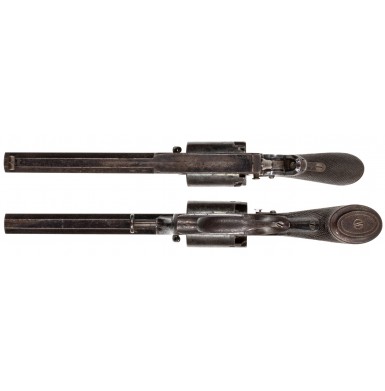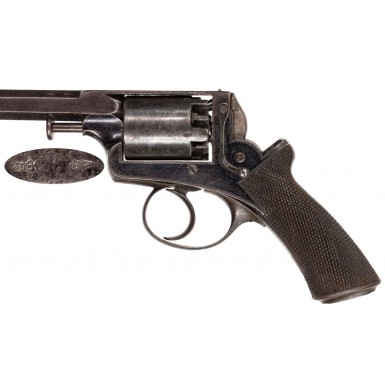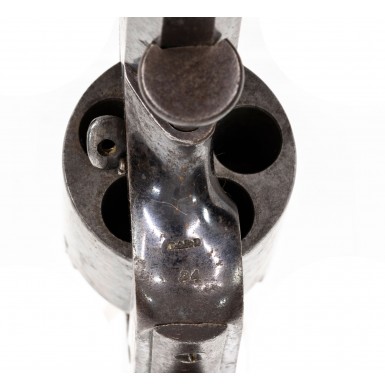Transitional Adams Model 1851 Double Action Revolver
- Product Code: FHG-JM044-SOLD
- Availability: Out Of Stock
-
$0.00
This is a very attractive example of an English Adams Model 1851 self-cocking (double action) revolver from the first part of the 1850s. These fine quality, solid frame revolvers were as important to the history and development of the revolving handgun as were the developments and designs of Samuel Colt. Robert Adams received his patent for a solid frame, one-piece revolver design in 1851. The patent covered his novel concept for a very strong revolver, where the frame and barrel were machined from a single steel forging. Unlike practically every other revolver design of the period, where the barrel and frame were separate components that were joined by wedges, screws, or some other mechanical system. Adams additionally patented a self-cocking lockwork, which today would be referred to as “double action only”. This mechanism cocked the hammer, rotated the cylinder, and released the hammer, all as the result of a single pull of the trigger. While this allowed for rapid fire, the long, heavy trigger pull inhibited accurate shooting. These designs were incorporated into Adams Model 1851 self-cocking revolver. The major drawbacks to Adams’ Model 1851 design were the heavy double action only trigger and the lack of an integral loading lever, requiring lading tools to be transported with the gun if it needed to be reloaded while being carried. In 1854 Lt. Frederick Beaumont developed an improvement for Adams’ lockwork, which produced what would be called a traditional “double action” revolver today. The new lockwork allowed the revolver to operate in the fashion of Adams’ original design (double action), but also added the facility to cock the revolver manually and fire it with a lighter “single action” trigger pull. This refinement allowed for more accurate shooting. Interestingly the development still required the trigger to rotate and index the cylinder on most versions, unlike Colt’s design, which rotated the cylinder simultaneously with the cocking of the hammer. In 1854 Adams also patented refinements to his original frame design by adding a sliding frame mounted safety on the right side of the frame and an improved cylinder arbor retaining mechanism as well. The resultant combination of design improvements was manufactured as the Model 1854 revolver, known to most as the Beaumont-Adams revolver. The revolvers were produced directly by Adams as part of his partnership with the London based Deane, Adams & Deane (circa 1853-1855), as well under license by gunmakers like Joseph Brazier and Isaac Hollis & Sons. Brazier and Hollis also produced frames under Adams’ license, which they subsequently provided to Adams for his company to build revolvers. Birmingham gunmaker William Tranter also employed Adams’ solid frame patent in the production of his revolvers but generally utilized lock works of his own design. Upon the dissolution of the Deane, Adams & Deane firm, Adams went to work for the London Armoury Company, and his revolvers were produced there as well. The London Armoury Company manufactured Adams patent revolvers both while he worked there from 1857-1858 and well into the production of the London Armoury made Kerr revolvers, circa 1860, some two years after Adams’ departure from the firm. Upon leaving the London Armoury Company, Adams went back to work producing his own revolvers, many of which were retailed by other London and Birmingham gun dealers and were often marked with the retailer’s name on the top strap. While most of the Beaumont-Adams revolvers were produced with loading levers designed by Adams, Joseph Rigby, or those patented by James Kerr (especially the guns manufactured by the London Armoury Company), a few were manufactured with a rather complex loading lever designed by Joseph Brazier. Joseph Brazier was a very successful gun, rifle & pistol maker in Wolverhampton, Staffordshire.
Many of the Beaumont-Adams revolvers encountered today are double “serial numbered”, with one “serial number” actually being the number that tracked the royalty payments due to Adams on his solid frame patent. These numbers are typically marked with a suffix letter that indicates the manufacturer using the patent (for example “T” for Tranter, “B” for Brazier and “X” for Hollis & Sons). Those pistols produced by Adams himself are usually suffixed with an “R” or with no letter at all. The second number has a “B” prefix to track the royalty payments due to Beaumont on his lock work patent. However, after the expiration of both patents, the guns are normally marked with only a single serial number and without any prefix or suffix letter. The Beaumont patent expired in early 1862, so these single serial number guns were most likely assembled after the expiration of his patent. As Adams allocated serial number ranges to licensees who had the right to manufacture guns on his solid frame principle, it can be quite difficult to date Adams revolvers by serial number, especially prior to the expiration of the Beaumont patent. According to English revolver authors & researchers W.H.J. Chamberlain and A.W.F. Taylerson, Brazier was allocated some numbers in the 30,000 B range prior to 1854, with the “B” suffix, while Adams himself produced revolvers in the same serial number range with an “R” suffix. They note that Hollis & Sheath never had their own serial number range but used their “X” suffix to distinguish their work, and that Adams often relied upon frames manufactured by William Tranter to manufacture his own revolvers! All of this clearly muddles the serial number picture for Adams handguns from about 1854-1860. From extant examples, however, it does appear that sometime in the mid-30,000 range serial numbers do become somewhat more consistent, and some inferences regarding dates of manufacture, attributed use, etc. can be drawn from the serial numbers of extant examples.
The Beaumont-Adams revolvers, in their .54-Bore configuration (about .442 caliber), were one of the best combat revolvers of the mid-19th century and as such a number of them were imported for use during the American Civil War. However, the lack of records makes it is difficult to ascertain exactly how many Adams’ patent revolvers were imported for use during the American Civil War. At least 1,075 were purchased directly by the US government. It is known that some military outfitters like Schuyler, Hartley & Graham purchased quantities of these revolvers for private sale to officers and those volunteer groups who looked to their state and local government (rather than the US government) to purchase arms. Some of the Schuyler, Hartley & Graham guns (about 300) are reported to have been purchased by the state of Alabama prior to the start of the war. Virginia and Georgia are reported to have made pre-war purchases of these revolvers as well. While the Confederate central government never directly contracted to purchase Adams patent revolvers, they concentrated on purchasing Kerr’s Patent revolvers from the London Armoury Company, Confederate speculators and individual states did purchase these fine English revolvers in some quantity. In fact, many Adams revolvers, manufactured by the London Armoury Company, are believed to have been in the L.A.C. inventories at the outbreak of the war. It seems quite probable that when Major Anderson and Commander Bulloch initiated their relationship with Archibald Hamilton (of Sinclair, Hamilton & Co, and the managing director of the London Armoury Company) that they arranged for a substantial number of these revolvers to be delivered to various Confederate states and to the Confederate Navy.
Several Confederate identified and presented Beaumont Adams revolvers exist in public and private collections, including #40537 in the Museum of the Confederacy. This revolver is cased with an engraved presentation plaque from Robert Adams to Confederate General Stonewall Jackson. Two other Adams revolvers in the low 41,XXX range are attributed to Confederate naval use aboard the CSS Shenandoah. Most Confederate war-time purchases are believed to have fallen within the 33,000 to 42,000 serial number range, although it is quite likely that guns produced prior to that range, and many of those previously imported to America, were used as well. In some cases the guns were “new old stock”, sitting on the shelves of London and Birmingham firearms retailers, that were sold to Confederate speculators. This resulted in some pistols that were several years old passing through the blockade. Civil War regiments that are known to have carried or been issued Adams’ patent revolvers include the 8th PA and 2nd MI cavalry on the US side and the 1st, 5th & 18th VA and 5th GA cavalry on the CS side. Two Beaumont-Adams are specifically listed by serial number on the Pratt List, a list of the revolvers by make and serial number in the possession of the cavalry squad of Lt. G. Julian Pratt, who served in Company H of the 18th VA Cavalry. The guns are #36604, carried by trooper James Tharp and #36609 carried by George Conrad. The squad roll is from July of 1864, and lists not only Adams, but also Kerr, Webley and Bentley revolvers. This primary source document is often used as a way to determine when certain English revolver serial numbers can be determined to have been definitively been in field service for the Confederacy. The list is often used as an indication that Kerr’s in the 9XXX range were in service at that point in time. In the case of the Adams revolvers, it shows they were in field service, but the serial numbers are from guns produced much earlier than 1864. A Confederate identified Beaumont-Adams; serial number 36853 is in a private collection, with a New Orleans retailers mark on the topstrap. Realistically, this places any Beaumont-Adams under that number as having been produced prior to the fall of New Orleans in April of 1862. It is generally assumed that the majority of the Adams pattern revolvers in Confederate service were 54-Bore bore (about .442 caliber), but a small number of 38-Bore (.50 caliber) revolvers of the earlier 1851 pattern have Confederate provenance as well.
This particular Adams Model 1851 Percussion Revolver is in about VERY GOOD+ condition and is an interesting gun as it appears to be a transitional model at the end of Model 1851 production and immediately before the production of Model 1854 revolvers. It is the classic 54-Bore (.442 caliber) handgun with a 5-shot cylinder and a 6 1/8” long octagon barrel. The obverse frame is engraved in a single line below the cylinder:
ADAMS’ PATENT . No. 13,765 R
The “R” suffix indicates that Robert Adams, as part of Deane, Adams & Deane, was the maker of the gun. The lower front of the frame web is marked
DA&D
54
indicating the caliber as “54-Bore” and that the frame had been produced by Deane, Adams & Deane as well. The top barrel flat is engraved in a single line:
DEANE ADAMS & DEANE . 30 . KING WILLIAM STT LONDON BRIDGE.
The cylinder bears the matching serial number and is engraved in two lines:
No 15028
R
The cylinder has the expected London commercial proof marks alternating between the chambers, a {CROWN} / V and a {CROWN} / GP. The barrel has a London commercial view mark, a {CROWN} / V on the upper left angled flat, as well as the expected {CROWN} / GP proof mark. It is difficult to date Adams revolvers from their serial numbers the way you can with Colt revolvers. However, it is reasonable to assume the revolver was produced circa 1854-1855 by Adams. The most telling indicator is the that the cylinder arbor pin is retained by the thumbscrew system that was part of Adams’ 1854 patent application for improvements to his previous design, rather than the earlier spring retention system. The revolver in unadorned and shows no engraved embellishments other than some simple boarder line engraving around the edges of the frame. The octagonal barrel is rifled with three wide grooves, roughly twice the width of the lands. The bore rates about VERY GOOD+ and is partly bright along its length and shows some moderately amounts of oxidation and some lightly scattered pitting in the grooves. As previously noted, the gun is in about VERY GOOD+ overall condition and retains some of its original blued finish. The barrel retains about 20% of the original bright polished blue, which has flaked and worn, leaving a mostly pleasing brownish-plum patina where the finish has worn away. The frame retains about 40%+ of its original finish, again showing some flaking and moderate wear, along with the expected fading, thinning and loss from handling and use. The barrel and frame are almost entirely smooth and are essentially free of any significant pitting but do show evenly scattered areas of moderately oxidized surface freckling and pinpricking present. There are also a few small patches more moderate surface oxidation on the rear face of the frame at the hammer cut out and on the hammer itself. The cylinder retains only dull traces of its original color casehardened finish, which is not uncommon. The casehardened cylinders typically “silvered out” if the revolvers were a lot, as the heat generated in firing the revolver quickly dulled the finish. The cylinder has a dark, mottled smoky blue-black patina, typical of an Adams cylinder that has seen some real use and service. Under strong light the patches of mottled color that have darkened and dulled can still be seen. The cylinder shows scattered surface oxidation and discoloration, along with some scattered pinpricking and some very lightly scattered pitting., most notably a thumb-sized patch about ½” above and to the rear of the serial number. There is also some minor pitting and moderately oxidized roughness in the recesses where the cones (nipples) are, typical of the wear caused by caustic percussion caps. The cylinder retains all of its original cones, and all are in fine and crisp condition. The hammer shows some speckled age discoloration, moderate oxidation, and some pinpricking. The trigger retains some traces of its original fire blue, but most of the finish has faded to a mottled silvery-gray color. The iron trigger guard retains only traces of its original blue, with the metal having a mostly smooth, untouched mottled gray-brown patina. The butt cap has a dark, even, plum brown patina with some moderate oxidation and some pinpricking. The gun retains it’s a Model 1851 patent spring safety on the reverse of the frame, which functions smoothly and correctly. The safety appears to be a very old, likely period of use replacement part. This is not uncommon as the delicate mechanism was easily damaged or broken and was one reason why Adams abandoned it on the Model 1854 design. By barely pulling the trigger the safety can be pressed into the frame, engaging the hammer, and creating a hammer block that also frees the cylinder to rotate for loading and unloading. The system is nearly identical to that found on the French Perrin revolver. Pulling the trigger automatically disengages the safety, allowing the gun to fire once the trigger is pulled fully to the rear. As noted, the usual Adams 1851 patent spring arbor pin retention mechanism is not present and the 1854 patent thumbscrew system is used instead. The assembly number 1263 is found on the rear face of the cylinder and is barely legible inside the triggerguard. It was probably inside the frame cut out as well but has been eroded by the caustic gasses that escape when the gun is fired. The gun was not further disassembled to look for other assembly numbers, due to the delicate nature of the action. The action of the revolver is mechanically FINE, and the gun times, indexes and locks up perfectly, as well as the day it was made. As with all the 1851 patent Adams revolver I have encountered, this one was produced without a loading lever apparatus. The revolver retains the original dovetailed front sight base on the top of the barrel, near the muzzle, but the blade is chipped and nearly all of the sight blade is missing. The original notch rear sight on the rear of the frame is undamaged. The checkered one-piece walnut grip is in about VERY GOOD+ to NEAR FINE condition. The grip is solid with no cracks or repairs noted. The grip remains in very nice shape, showing only the minor wear, due to handling with very fine, crisp checkering that shows only the most minimal flattening to some of the sharp points. Overall, the condition of the revolver is indicative of a gun that saw some real world use and was actually fired to some degree during its lifetime but was always well cared for.
Overall, this is a nice condition example of a relatively uncommon transitional 1851 to 1854 type Adams Model 1851 Revolver from the period of the Crimean War. These guns were popular with young officers who were required to provide their own sidearms and many of Adams early revolvers got their first combat testing during this conflict. This would certainly be a worthy addition to any collection of mid-19th century percussion revolvers, particularly one that centered on English handguns.
SOLD
Tags: Transitional, Adams, Model, 1851, Double, Action, Revolver











